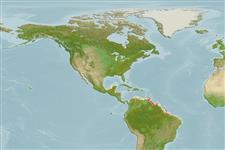Common names from other countries
Classification / Names / Names
आम नाम | उपशब्द | Catalog of Fishes (gen., sp.) | ITIS | CoL | WoRMS
Environment: milieu / climate zone / depth range / distribution range
पारिस्थितिकी
. Tropical
Western Central Atlantic: Southern Caribbean and northern South America.
Length at first maturity / आकार / वज़न / Age
Maturity: Lm ? range ? - ? cmCommon length : 4.0 cm TL पुल्लिंग / अलिंग; (Ref. 344)
Shell outline subtriangular, as high as long, inflated, heavy, slightly pointed posteriorly. Sculpture of well-defined concentric threads. Hinge with 3 cardinal teeth situated under umbo; 1 anterior and 1 posterior lateral tooth. Lateral teeth smooth. Ligament long, narrow. Periostracum with minute scales, fuzzy. Colour: externally cream-white, sometimes tinged with purple or grey, internally white often stained with purple and frequently with darker radial stripes at both ends; periostracum pale or dark brown.
Infaunal in mud or sandy-mud in estuaries, mangrove swamps and coastal lagoons (Ref. 344).
Life cycle and mating behavior
परिपक्व अवधि | पुनरुत्पत्ति | मछलीऔ का अंडे देना | अंडे | Fecundity | लार्वा
Members of the class Bivalvia are mostly gonochoric, some are protandric hermaphrodites. Life cycle: Embryos develop into free-swimming trocophore larvae, succeeded by the bivalve veliger, resembling a miniature clam.
Leal, J.H. 2003. (Ref. 344)
IUCN Red List Status (Ref. 130435)
CITES status (Ref. 108899)
Not Evaluated
Not Evaluated
Threat to humans
Harmless
Human uses
मात्स्यिकी: व्यापारिक
| FishSource |
साधन
इंटरनेट स्रोत
Estimates based on models
Price category
Unknown.
